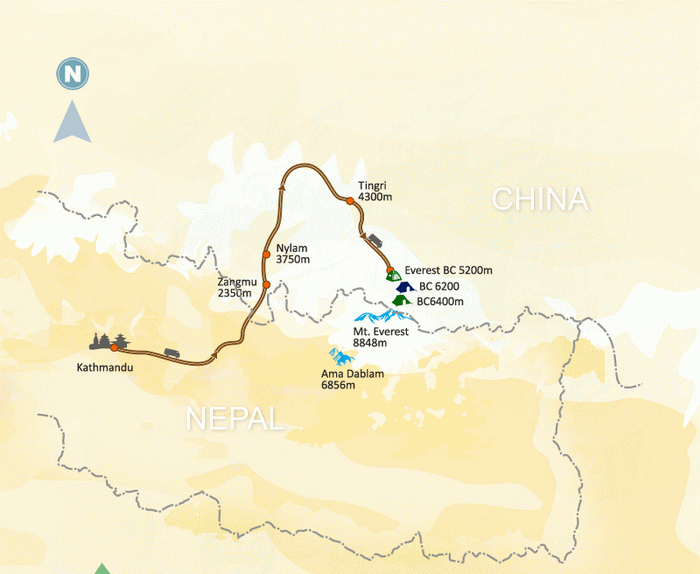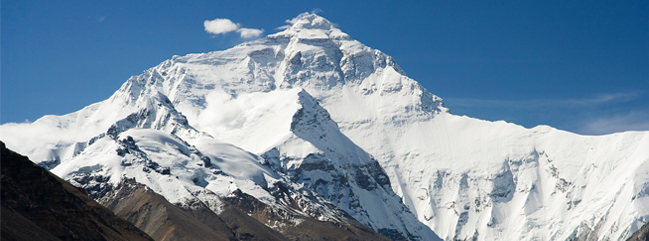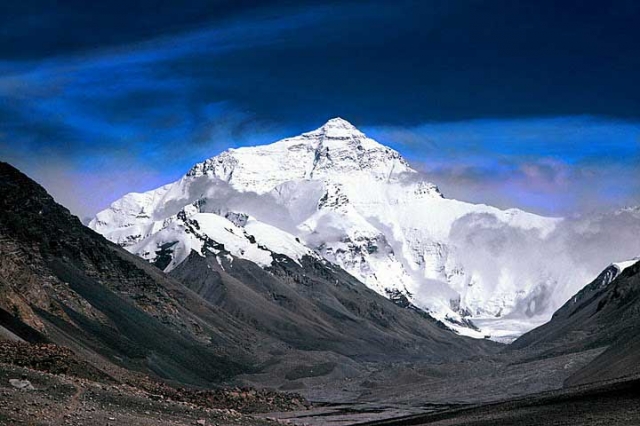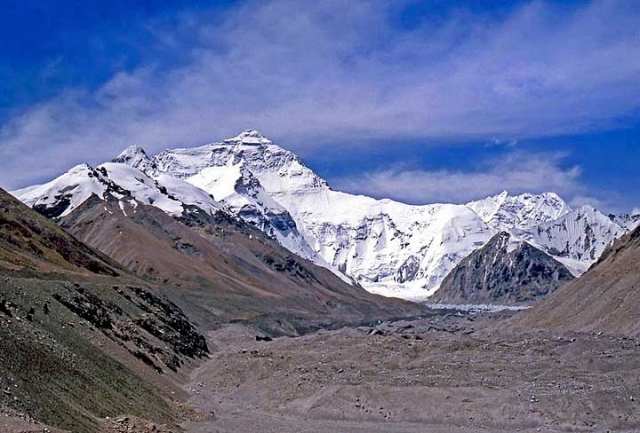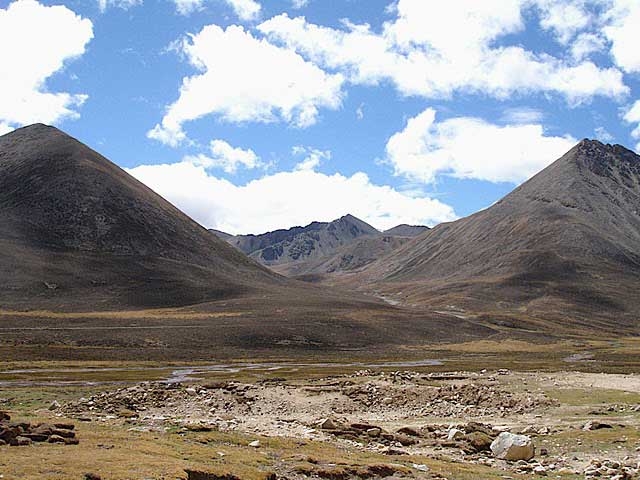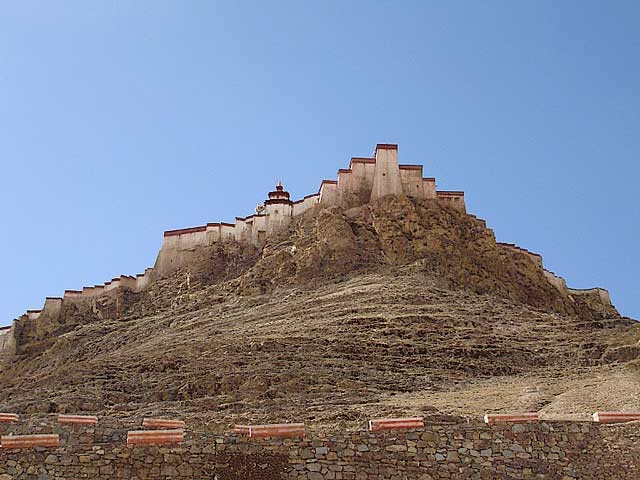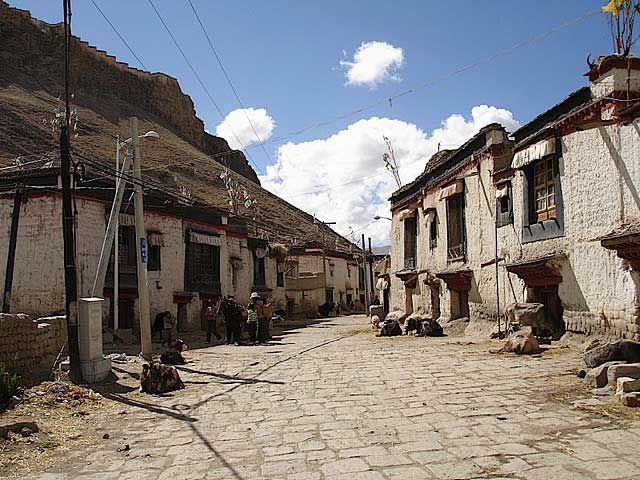Everest climb via North (Tibetan) side is the least expensive way to climb it. The trip begins in the ancient and colorful city of Kathmandu. On the Friendship Bridge, border Crossing between Nepal and Tibet. Upon entering Tibet, the clocks immediately go forward by 2 hours. Our secondary government liaison officer will meet us in Zhangmu. After clearing Tibetan customs and immigration, a Chinese bus takes us up the windy road through the rolling hills to Nyalam town at 3,750 meters, and a basic “hotel”. The smaller towns in Tibet are generally simple and rustic places, and this one is no exception. The topography here is quite interesting in that we are perched in the transitional zone where the Tibetan plateau rams into the Himalaya, then drops into the forested valleys and jungles of Nepal, and finally out into the Gangetic plain of the Terai and India. We stay over one extra night in Nyalam, to help adjust to the altitude, and during our “rest-day” in Nyalam, we take advantage of the interesting surroundings to walk to the top of local hills and savor the first glimpses of the Himalayan Giants.
Everest North or South?
Kiwi Sherpa run expeditions to both sides of the Everest – to the North Ridge and to the South Col route. We run an expedition to the South Col because this remains the most popular choice for first-time “Everest climber,” as it gives the most assured means of reaching the top. Simply, the time spent at over 8,000 meters on the South side is less, as the summit is attempted from the South Col (just under 8,000 meters) in one push. On the North Ridge, the top camp is located at 8,400 meters, which means you will be exposed to the extremes of altitude for appreciably longer, spending at least one night there during the summit attempt. The south side has a good record of success, not least because a lot of people go that way, but also because of the momentum that these people generate, especially once the route to the top is opened by each year’s first ascentionists.
However, the North Ridge has become more accessible in recent years, and for those able to cope with the tougher physical demands imposed by the route, it gives a more cost-effective means of getting to the top. It also avoids the Hilary Step, which can become an insurmountable obstacle purely because of the number of people trying to negotiate it on summit day. However, technical interest is similar, if not more sustained on the North Ridge, as longer passages are on rock, with a series of “Steps” to be negotiated on the way to the summit.
Day 01- Arrival in Kathmandu Airport (1345meters).
There you will be met by our Airport Representative and transferred to hotel by private tourist vehicle. Overnight at hotel.
Day 02- Pre-trip Meeting and Sightseeing around Kathmandu valley.
In the morning after breakfast at 9 AM, we host a Pre-Trip meeting at your hotel in Kathmandu and introduced your expedition Leader/Guide and Sherpa team, at the same time it will provide an opportunity for individuals to ask questions about the your tour and to introduce you to other participants. This includes a final briefing and preparations for the trip.
PLEASE ADVISE US IF YOU WILL BE ARRIVING LATE AND ARE THEREFORE UNABLE TO ATTEND THE PRE-TRIP MEETING.
In THE PRE-TRIP MEETING All passengers MUST bring:
1. Passport.
2. Four copies of Passport size photos each.
3. Travel Insurance Policy.
4. A writing pen
5. Notepad.
After the Pre-Trip meeting and breakfast your sightseeing trip will start at 9.45 AM in the morning. We provide a private vehicle and professional tour guide. We visit Bodhnath Stupa, one of the biggest Buddhist shrines in the world, where we observe Buddhist monks in prayer in the monasteries surrounding the stupa. After Bodhnath Stupa we visit Pashupatinath, the most famous Hindu temple in the country, located on the banks of the holy Bagmati River. Here we see Hindu holy men (sadhus) meditating, pilgrims bathing and occasionally funeral pyres burning on the ghats. We also visit Bhaktapur Durbar Square, which is a collection of pagoda and shikhara – style temples grouped around a fifty-five-window palace of brick and wood. The attraction of the Bhaktapur Durbar Square is The Lion gate, The Golden gate, The Palace of fifty five windows, Art Galleries, The Statue of King Bhupatindra Malla.
The rest of our time in Kathmandu is free for further exploration and some last-minute shopping in Thamel area near by your hotel. Later, we are supplied with our Trip Pack and information for tomorrow. Overnight at hotel.
Day 03- Official formalities in Kathmandu.
Formal briefing in the Ministry of Tourism. Today, the expedition leader will also check everyone’s equipment. Overnight at hotel.
Day 04- Final Preparation day in Kathmandu. Overnight at hotel.
The last opportunity to buy anything missing.
Day 05- Fly from Kathmandu to Lhasa (3660meters). Overnight at hotel.
Early morning transfer to the international airport for the hour-long flight to Lhasa. This stunning flight, on a China Southwest Airlines Boeing 757, takes us right across the main Himalayan range and provides us with magnificent mountain views. After landing at Gongar Airport and meeting our local Tibetan Sherpa, it is a further 2-hour drive by Land cruiser to Lhasa. It’s advisable to rest and take it easy for the remainder of the day due to Lhasa’s altitude. Overnight at hotel.
Day 06- Sightseeing in Lhasa. Overnight at hotel.
We spend today visiting several of Lhasa’s many monasteries in the company of a guide and interpreter. One of these is the Sera Monastery, one of the best-preserved monasteries in Tibet, within its whitewashed walls and golden roofs, several hundred monks live and study. After lunch we’ll visit the Norbulingka, the summer palace of the Dalai Lama, as well as the Jokhang Temple. This temple is possibly the most sacred shrine in Tibet and there is always a procession of devout Tibetans through the complex. Surrounding the Jokhang is the Barkor – a maze of narrow cobbled streets that is the central market of Lhasa. Overnight at hotel.
Day 07- Second day of sightseeing in Lhasa. Overnight at hotel.
In the morning, we visit Potala Palace which dominates the city of Lhasa it’s a spectacular building, containing private quarters of the Dalai Lama as well as numerous grand state rooms and many important chapels. There has been a Palace on this site since the 5th or 6th century, but the present Palace was constructed in the 17th century. After lunch, we visit the Drepung Monastery, which was founded in the 14th century and was once the largest in the world, with a population of around 10,000 monks. These days that figure is down to several hundred, but there is still much here of interest as it was left relatively unscathed during the Cultural Revolution. Overnight at hotel.
Day 08- Drive to Gyantse (3950meters) – 261 k.m. Overnight at hotel.
The day begins with our overland journey towards Rongbuk valley. We follow the Friendship Highway by jeep, we cross the Khamba La at elevation of 4794meters from which there are stunning views across the waters of Yamdrok-tso Lake to the snowy summit of Nazin Kang Sa 7252meters. As we continue our journey to westwards over another high pass the Karo La 5045meters, we can view the spectacular sight of a huge glacier tumbling down to within a few hundred meters of the road. After few hours, we arrive to Gyantse passing the beautiful valleys and colourful Tibetan villages. Overnight at hotel.
Day 09- Drive to Shigatse (3900meter) – 90 k.m. Overnight at hotel.
This morning we visit the Gyantse Dzong. This fort dates back to the fourteenth century and offers some of the most amazing views of Gyantse and surrounding valleys. Before leaving we also visit the famed Gyantse Kumbum. This magnificent tiered structure is the largest stupa in all of Tibet. If the exquisite gold dome is not enough, this stupa is packed with Tibetan sculptures and paintings.
Thereby, we continue the trip to Shigatse, the second largest city in Tibet. It is only about a 90 km drive taking us to Shigatse which is a laid back city that provides excellent opportunity for both relaxation and exploration. Thereafter, exploring the local market we will make a detailed visit to the Tashilhunpo Monastery, one of the largest functioning monasteries in Tibet. Overnight at hotel.
Day 10- Drive to Shegar (New Tingri) (4050meters) – 244 k.m. Overnight at hotel.
The views of this desert plateau provide wondrous entertainment as we travel along the Friendship Highway. This stretch is the most spectacular landscape in Tibet. After passing through the small town of Lhatse we will cross Gyatmso La elevation of 5220meters, the highest pass on our journey. The land quickly descends to plains after Gyatmso La. While travelling through the plains we will see many nomadic herders, quiet countryside, and secluded monasteries. Overnight at hotel.
Day 11- Drive to Ronguk (5000meters) and hike to Everest Base Camp (5150meters). Overnight at tented camp.
Today we leave the main Lhasa to Kathmandu highway and head due south towards Everest. We drive over the Pang La, which will hopefully give us our first good views of Everest, some 40 miles away. Then we descend to a village in the valley floor, and continue up the valley to base camp. The road becomes rougher and rougher, but the scenery becomes more spectacular as we round each corner. Finally there is the awesome north face of Everest, at the head of the valley before us. From base camp, it does seem very close, but it is still 12 miles away.
Day 12 to day 16- Acclimatization and local exploration. Overnight at tented camp.
We spend 4 days at base camp while our bodies adapt to the altitude. This gives us plenty of time to enjoy the views, and photograph Everest. For those who are feeling up to it, there are plenty of hillsides to scramble up, and we can walk down the valley to Rongbuk Monastery, 5 miles / 8 km away. Another worthwhile objective would be to reach Tillman’s Camp, an idyllic spot beside the majestic Central Rongbuk Glacier, which offers staggering views of the north side of Everest. It is important not to overdo it during this period – there will be plenty of opportunity for exertion later! We must work at resting, while drinking plenty of fluids and enjoying the base camp food.
Day 17- Trek to First Interim Camp (5,680m). Overnight at tented camp.
The trek starts easily enough, crossing the pebble floodplain of the Rongbuk River, then weaving along a good path between the glacier and the valley side. After about 2 hours we reach a good viewpoint, then turn steeply up to the left, leaving the main central Rongbuk valley. This takes us up into what seems to be a fairly small subsidiary valley, but it soon opens up to reveal the amazing pinnacles of the East Rongbuk Glacier. It was the discovery of this approach in 1922 that provided the key to climbing this side of Everest. We camp in a very pleasant spot, with plenty of space, no more than 2 hours after having turned into the East Rongbuk Valley. The camp is located on the right bank, overlooking the river below, and is short of the moraines and the toe of the glacier that lie ahead.
Day 18- Trek to Second Interim Camp (6,088m). Overnight at tented camp.
Crossing small streams and moraines, we gain the opposite side of the valley and contour along it until the valley makes a very definite swing north.
Here will be the site for our interim camp for future journeys between base and advance base but, for now, it marks the climb onto the glacier proper and the start of the Magic Highway. On subsequent journeys up the East Rongbuk Glacier, we will be fitter and better acclimatized, enabling us to complete the trek to ABC easily in two days, hence this will become the site of a single interim camp located where the glacier sweeps north (c5,890 metres).
The Magic Highway is an unlikely tongue of moraine that passes down the middle of the treacherous ice pinnacles of the East Rongbuk Glacier. The route is surprisingly level, with little height gain for the effort expended as the altitude makes it tough.
Once on the Magic Highway, the conditions become more austere than during the previous day’s walk, with ice and moraine constant companions from here on. At the start of the season, the streams on the glacier will be slight, carrying little water. However, as the season progresses through spring, and towards summer, some of these streams will become torrents, that will require frequent changes to the route in order to cross them safely.
The Highway finally drifts in toward the east ridge of Changtse, where a lake often forms. The interim camp is reached after a 5 hour day of slow walking and nestles close to the entrance of the cwm to the north of Changtse, near to this moraine lake.
Day 19- Trek to Advance Base Camp (6,440m). Overnight at tented camp.
The re-appearance of Everest is a pleasant distraction during the final climb and, as you round the corner towards advance base camp, you can see the whole of the North East Ridge, from the Raphu La to the summit. The shimmering triangle of snow, that highlights the summit over 4 Kilometers distance and 2 Kilometers higher, will issues its siren’s call, until your footsteps cross it!
Day 20 to day 58- Climbing period of Everest 8848 meters from North Ridge. Overnight at tented camp.
It is impossible to prescriptive about how the mountain will be climbed from this point on, as it will be matter for the leader and the team. For those that have been to extreme altitude before, we would aim to be as flexible as possible to allow for people’s preferred acclimatization routine. For some, this may mean climbing as high as camp 3 on the North Ridge, as soon as possible, before diving back to base camp for a long rest. Others might want to remain longer in ABC, taking several trips to the North Col and sleeping there overnight but not going any higher, for example.
Whatever routine is adopted for acclimatization, as soon as everyone is happy that they have achieved an optimum state of readiness, the team will return to base camp for a long period of rest and eating.
After many days of resting and preparing, we return once more to ABC, using the single interim camp at the start of the Magic Highway, en route. Again, we pause in ABC, to eat some more and to ensure that everything is in place, and the weather is set as fair as possible. Then we head up. The route to the North Col will be well-known entity, as its slopes will have been ascended a few times by each of us as part of our acclimatisation process. However, we should find the meters slipping by more easily, as sights are now set on the very pinnacle of the mountain.
From Camp 1 on the North Col, the route turns to follow a long snow ramp, the north ridge proper, that rests like a gigantic flying buttress supporting the upper reaches of the mountain. Although never steep, this section is prone to wind, sweeping icily across the mountain. After a full day, we reach camp 2 located at the head of the ramp.
From here, the route moves on to broken rocky ground of shattered shale, as the north ridge cast off its layers of snow. However, the route remains relatively easy angled, although the gradient increases gently, until the next camp is reached. This is located where the mass of the north ridge rams home hard against the bulk of the mountain, on rocky shelves. The day is rewarded with stupendous views over the glaciers below. What were viewed as big mountains as they dominated the Magic Highway, now more easily blend with the humble backdrop of the Tibetan Plateau and the flatlands beyond.
The top camp will give you an even greater sense of the world below your feet. The ascent remains on broken ledges, but these are easy with shale and scree interlacing between them until snow runnels give out onto the north face proper. Once clear of the rocks and on more open slopes, you turn directly upwards, to arrive at the final camp at about 8,400-metres.
Summit Day
Summit day begins before mid-night! Leaving the tents in the still of the night, you headlamps shine up to pierce the darkness and illuminate a faint gully that leads to the ridge above. This line through the rocks is steeper than those traverse the day before, but the fixed ropes help lift you towards the skyline. Some scrambling, accompanied by a disproportionate amount of panting, will land you on the ridge at over 8,500- meters. The only thing now between you and the top, is about 400 meters of ascent, 3 rock steps and over a kilometer of ridge – the ultimate tightrope! As dawn breaks, you will see the awesome Kangshung Face falling off to your left – a mind-boggling drop in to Tibet. For the main part, you remain on the right flank and traverse easily in places, but the route is punctuated by the First, Second and Third Steps. The hardest of these is the Second, which has a ladder and fixed rope to allow an ascent, which would be virtually impossible otherwise. Additionally, you can expect an airy traverse en route to gaining the top. Finally, however, the mountain yields, and the final summit snowfield, that you had seen from miles below will come under your feet and herald your arrival to the Top of the World.
Day 59- Packing personal equipment at base camp. Overnight at tented camp.
Day 60- Depart base camp and drive to Zangmu. Overnight at guesthouse.
We undo our remarkable road journey across the Tibetan plateau. We overnight in a hotel, at Zangmu, ready to cross back into Nepal at first light.
Day 61- Drive Kathmandu from Zangmu. Overnight at hotel.
Once back in Kathmandu, Kiwi Sherpa will host an evening barbecue to celebrate the expedition and as a farewell party to thank the Sherpas and the team member for their support and friendship during the expedition with the hope of seeing you all again for next expedition.
Day 62- Leisure day in Kathmandu. Overnight at hotel.
Leisure day in Kathmandu
Day 63- Transfer to international airport for your final flight departure.
The trip ends, our Airport Representative will drop you to the Kathmandu International Airport for your flight departure from Nepal.
PLEASE NOTE: The above itinerary is not a fixed program but is intended to give an indication of the likely events during the expedition. Please note that because of climbing Everest, it will be necessary to have a flexible plan in order to take the best advantage of situations as they present themselves. Any changes to the itinerary will be made with a view to maximizing the benefit to the team members and of ensuring their eventual success on the mountain.
Normally climbers will change their departure flights from Kathmandu when they know exactly when the expedition is going to end. We plan to stay at Base Camp for climbing as long as it takes us to be successful.
Team members should take out private insurance if they wish to be covered against cancellation due to medical or personal reasons. This is called trip Cancellation insurance and can be obtained from your normal travel agent.
Q. I want to climb for Expedition, but there are so many options and the cost is high! Why should I choose Kiwi Sherpa ? What makes you different to other companies out there?
A. As we all know that when you make a decision to climb for expedition, it is one of the most financially challenging trips to come on. Our prices compared to other outfitters that provide the same product, services, if not a lesser product are actually less! We invite you to shop around and compare, both in price and quality. We feel strongly that you will find us to be the best in the business.
One of the main things that set us apart is our attention to detail. Nowhere else you will find a team of people more dedicated to your success! From the time you contact the office to the time you step on the mountain, our customer service is the best.
Our trip prices are much more reasonable compare to many global based companies; it is not because we are economical in service in which we operate. We are local operator therefore we DO NOT re-sell or use second party or agency. Many international companies will take anything from one third to three quarters of the profits this is how your trip price makes huge unusual.
Q. How the Expedition will operate?
A. After meeting all your team and crew in Kathmandu we fly by helicopter, drive by vehicle or fixed wing plane directly to the destination and then we start for trekking. Acclimatizing along the way and relishing in the hospitality provided by our Sherpa friends we reach base camp and after some rest and preparation we begin the ascent. Base camp will be a collection of sleeping tents, as well as a large kitchen and dining tent. We utilize the services of specially trained Sherpa cooks and we import a lot of high quality food to supplement the local produce available. The guides and Sherpas will fix rope on the route and stock the camps with provisions and equipment. By utilizing fixed rope we can climb in average weather, and, if necessary descend to base camp with little problem in case of a major storm. Two or three climbing Sherpas will assist with the load carrying but no more will be engaged in order to avoid clogging the route and spoiling the nature of the climb. When the fixed line is in place, and the two camps are established and stocked, we will climb back up the ropes and make a bid for the summit. Sufficient supplies will be available to support all members. Guides and Sherpas will carry all group gear but members are expected to carry their own personal gear. Radios will be used to co-ordinate the movements on the mountain and provide a safety back-up for the lead team.
Q. Can my friends and family come along to base camp for the expedition?
A. Sure! This is one of the best points to start the expedition, having family and friends trek to base camp to see you off on your journey. Base camp for non-climbers is not a very hospitable place, but we strive to make your guests comfortable and welcome. Guests for the duration of the expedition are allowed on a case by case basis. The reason for this is simple. On the trip, our job is to be climbing, spending time just at base camp can be quite boring sometimes, so we usually encourage guests to trek in at the beginning or end of the expedition, to join you during the most exciting parts of the trip! Contact us for cost and details.
Q. As the trip is so long, can I bring food and other gear not on the list?
A. Of course! Most people on the Expedition, members end up bringing “the kitchen sink”! We encourage you to bring some of your favorite goodies and tech toys, as base camp will become our home for 2 months or so. The more comfortable you are, the more energy you have for the climb, so every little thing helps!
Q. Is there a private trip option too? If yes, how does that work and what are the costs?
A. Doing Expedition is a once in a lifetime experience, we wanted to make sure you have every possible advantage. Some clients enjoy the added privacy and schedule flexibility that a private expedition allows. A private means you will have your own guides, your share of the Sherpa carry staff, a private dining tent, and optional private communication facilities. This allows you to climb at your own pace, and enjoy the mountain on your own terms. The costs vary depending on how many clients there are in your private group. Please contact the office for details.
Q. Are the skills/prior experiences required for this climb?
A. Simply, You cannot just decide to write a cheque and go and climb for Expedition ! A comprehensive climbing resume is required to join our team. The most required factor on our ‘Kiwi Sherpa’ is that the participants must have a solid understanding of mountaineering skills. This should include previous high altitude experience of at least 6,000 meters, mixed with a multitude of Alpine mountaineering and, preferably, you will have taken part in a previous 8,000-metre expedition. Please let us know if you want us to arrange training program in some of the 6000 and 7000 meters peaks in Himalaya before your expedition begin.
Q. What is the conditioning level needed for this climb?
A. You should be in the best shape of your life! This is our longest expedition of the year. It requires patience, stamina, mental fortitude, and a strong will. Summit day can sometimes be over 20 hours long! Day by day the challenges are different, but the more prepared you are, both mentally and physically, the smoother your trip will go.
Q. In a team, how many climbers will be on this expedition?
A. Maximum 10 members can be included on our Kiwi Sherpa. This is to ensure that we can maintain safety and our attention on detail. There may be more in base camp and in the camps on the mountain if there are private expeditions, but they will generally travel separately from the main team.
Q. Will I be sharing a tent or room with other climbers? Is there a single room option on this trip?
A. You will have your own tent in base camp, but on the mountain, you will be sharing a tent with others. We generally book you in to a single room in the hotel in Kathmandu whilst it is twin share in the lodges on the trek into base camp. A single supplement is available. Please contact us for further details.
Q. How heavy will my pack be?
A. It will depend on the day. On a “carry” day, where you are moving your personal gear between camps, your pack can be 20-40lbs, equal to 9-18kg , sometimes higher if you choose to carry more of your equipment. On “move” days, the weight goes down significantly, to 10-15lbs., 5-7kg.
Q. What kind of food do you have on the mountain? Or at the base camp?
A. All these will depend on what camp we are in. In the base camp, we import tons of food from Kathmandu. So don’t be surprised by our sushi nights, fresh muffins, yoghurt for breakfast, and pizza! On the mountain, we usually have a wide variety of meals; these are significantly tastier than freeze dried, as they are real food and ready to heat and eat! At Camp 2, our advanced base camp, we have Sherpa cook staff, who prepare more ‘base camp like’ food. Pizza, pasta, eggs and bacon! We work hard to make sure our food is second to none.
Q. How long will be a typical day on the mountain?
A. It depends on the day and your level of acclimatization. At the beginning of the trip, everything seems slower and longer, but as you get more adjusted to the mountain, the days go quicker. Average days can be 5-10 hours long. Summit day can be up to 20 hours long.
Q. Is communication possible on the expedition? If yes, what its type?
A. Experience has shown how important it is on expedition to be able to talk to every team member, at all times. If you join Kiwi Sherpa on expedition, you will have a dedicated radio. Each Sherpa will also have his own radio, so that at all times we can keep in touch with everyone, and everyone can keep in touch with each other.
Base Camp is equipped with a lap top and high speed satellite connection. The satellite communications are also used to send back regular reports, every couple of days, to Kiwi Sherpa office.
Q. What sort of hotels do we stay at in the city?
A. We use standard rooms from three/four star hotels in Kathmandu with breakfast included.
Q. What time should I arrive and where do I meet my guides?
A. There will be an Kiwi Sherpa representative at the airport to meet you, and the first of many team briefing occurs in the evening of day 1 and 2 in Kathmandu with our local Sherpa guides.
Q. How much should I budget for this expedition? How much cash should I plan to bring?
A. Since this is our biggest and longest trip, we usually suggest our expedition members to bring USD$2000 -$3000. This will cover everything from gifts, to bottled drinks, tips, and anything else that catches your eye on the trail. ATM cash machines work in Kathmandu, but only pays the local currency, Rupees.
Q. How much should I tip my guide staff?
A. This is a difficult thing to gauge. We have seen everything from 100USD to 15,000USD for an Expedition tip. Tipping is not required, but a small way to show your guides thanks for their help. The level of the tip should reflect the level of personal involvement with your guide.
The suggested tipping are as follow:
– Allow $150-250 for general non-sherpa crew who stay at base camp.
– Allow $200-350 for sherpas who go up to the base camp.
– Summit climbing Sherpa US$ 1000 – 1500 per Sherpa.
Q. What if I arrive early or depart late?
A. As long as possible, we request you to arrive in Kathmandu on the assigned date, to assure your baggage makes it on time, and you have time to recover from jet lag before trekking. It is hard to catch the group if you are arriving late and still waiting for lost baggage! We can arrange extra nights in the hotel. Many people depart from our Nepal expeditions later, to enjoy the sights and sounds of Kathmandu, but do keep in mind that this is long expedition and we find that people want to head home as quickly as possible after the climb finishes.
Q. Are there any entry or visa requirements?
A. Yes there are. Be sure to have the suggested USD amount in cash for your visa application and have a passport, photos for your arrival in Kathmandu. You will receive your visa at the airport, and we will add extra days later, as you are only ever issued a 90 days visa when you first arrive.
Q. Could I have my own personal Sherpa?
A. In our normal expedition you carry your personal equipment; sleeping bag, mattress/s, down suit, snacks, clothing while the sherpas carry the meals, gas, stoves, tents and oxygen. The team climbs together between camps and a climbing sherpa will also accompany you to the summit. This is a good level of service, and suits most people, however if you want an additional climbing sherpa to assist with your personal equipment and to climb with you all the time, we can provide. Please contact us.
Q. What kind of insurance do I need?
A. We invest in insurance coverage for commercial liability and medical and disability insurance for our employees and Sherpas while participating on our programs. We cannot insure you for your personal needs, but we do expect you to be as fiscally responsible as we are. We strongly recommend that you insure yourself against potentially expensive difficulties that may arise. First, trip cancellation insurance may provide financial relief should you be forced to withdraw from the climb before it even happens. Next, make sure you have adequate traveler’s medical and evacuation insurance for coverage should you have a problem during the trip. Medical care and evacuation from mountain can be expensive.
For the Rescue and Evacuation, Kiwi Sherpa strongly recommends that you purchase a Global Rescue membership to protect yourself and your family. We give you our word that you will be safer as a result. We are an authorized agent of Global Rescue, click here to sign up the membership plan today.
Q. Are the Kiwi Sherpa staff insured?
A. Our company insures all our trekking staff, including guide, cook, sherpa and porters.
Q. Can’t find your question here?
A. Contact us for further information!
Cost Includes
• Airport / Hotel / Airport pick up & drop by private car / van / bus.
• Standard twin sharing accommodation in three/four star hotel in Kathmandu breakfast included. (6 nights)
• Guided city tour in Kathmandu by private car / van / bus.
• Full board meal during the trek and camping at base camp, prepared by our cook with hot Tea & coffee.
• All base camp and Advance base camp camping gears (We will provide fully water proof dining tents, kitchen gears, dining table, chairs, toilet tents, shower tent at the base camp and advance base camp)
• High quality tents for all camps.
• Insurance for all Nepali staffs and porters including helicopter rescue provision.
• Boiled and purify drinking water for the trek and at base camp.
• Expedition permits
• Liaison officer and his round trip flight, insurance, wages, expedition equipments etc.
• High altitude climbing food, fuel, Gas above base camp (you are also advised to bring some high altitude food yourselves)
• Guide, cook, porters, helpers up to base camp
• Climbing Sherpas (1 member = 1 Sherpa Ratio on climbing day)
• A well stocked first aid and medical kit sufficient to counter any possible mountaineering ailments, from headache to serious injury.
• Oxygen equipment for medical use only.
• A portable hyperbaric chamber (Gamow bag)
• Emergency communications on the mountain and satellite communications link for helicopter evacuation.
• Oxygen 7 bottles per team climber and 4 bottles per Sherpa.
• Mask regulator
• Sightseeing/Monument entrance fees in Kathmandu.
• Welcome dinner for members in Kathmandu.
• Power supply at Base Camp for charging electronics (solar and generator backup)
• Flight cost from Kathmandu – Lukla – Kathmandu including airport departure tax at both airport.
• All our government taxes and vat.
• Farewell dinner party in Kathmandu.
Cost Excludes
• Lunch and dinner whilst in Kathmandu.
• Travel Insurance which cover emergency Rescue and Evacuation. (Kiwi Sherpa strongly recommends that you purchase a Global Rescue membership to protect yourself. We are an authorized agent of Global Rescue. Read about our emergency helicopter RESCUE & SECURITY EVACUATION Policy)
• International airfare and airport departure tax.
• Nepal entry visa fee (Tourist Visa with Multiple Entry for 90 days can be obtained by paying US $ 100 in Kathmandu airport up on your arrival. You will also require 2 passport size photos You can easily extend the visa if require.)
• Items of a personal nature such as alcoholic drinks, cold drinks, laundry.
• Personal trekking and Climbing Equipment.
• Any others expenses which are not mentioned on Price Includes section.
• Garbage Deposit USD 4000.00 (sharing from climbing group). It is refundable; however, it will not be refundable if the climbers fail to take back their garbage to Namche Bazar and Kathmandu.
• Excess baggage charges.
• Sherpa tip pool (See below)
• Internet and sat phone.
• Costs incurred as a result of delays or events beyond the control of Ace the Himalaya.
